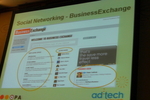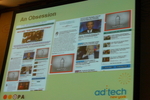DigiPublishers: Context is (Still) King, and Don't Be Afraid to Leer
Publishing in the Digital Age -- Context is King.
It's odd that an ad:tech panel about publishing need reiterate the importance of context. Even before digital blew our minds or whatever, wasn't that still the case? Great newspapers were forged in the fires of noteworthy current events. Great books exploit widely-felt (but little-articulated) sentiments.
Context has always been king. Tactical marketers have always fed on that: This is my message. How best to package it for Demo X? Where is their mind? Can I speak to a shared passion or crisis?
This sesh gives a fresh coat of paint to a trusty old model, with the crucial addition of being whiplash-worthy. (That is, encourage some hardcore rubbernecking.) Highlights below.
BusinessWeek's BusinessExchange
"We saw a study [showing] people that consume news or info typically rely on about 16-18 brands per week," said John Byrne, executive editor of BusinessWeek.com. People glean news from multiple sources; nobody ever reads just one site, he said.
BusinessExchange, a new BusinessWeek.com product, leverages that tendency. Like a cross between Google Alerts and Wikipedia (which lets users build on stories over time), it enables users to follow a beat -- for example, to read every story about Yahoo's slow, sad dance into Microsoft's arms. Users can also share stories with other network members, or add a story that the Exchange didn't index. ("News" bloggers, I'm sure, will go wild.)
"You wanna have a way to sort and sift through [data] that respects your time restraints," Byrne explained, adding that the Exchange enables users to indulge a growing inclination to "organize around micro-communities."
So far, user-developed topics include "conscious capitalism" and "commercial space travel" -- unexpected insights into a rapidly-changing worldview. There are over 700 such items now, and BusinessWeek expects well over a thousand by year's end.
There's also a somewhat-creepy feature that lets you read what someone else in your network is reading -- in real time. Byrne called it the "voyeurism concept."
"You can peer 'over the shoulder' of someone in the network - either in a given community or topic, or network-wide, and see exactly what they're doing inside the product. There are privacy safeguards if you wanna turn them on."
So far, advertising on BusinessExchange sites have exceeded expectations and outperform the core site. One component of this is that dynamic content sites are rapidly indexed by Google. 365,000 pages have been indexed so far.
"When I type my name into the Google search bar, my profile on this product appears before my profile on LinkedIn or anywhere else," Byrne boasted.
HuffingtonPost's Staring Problem
HuffingtonPost.com is one of the fastest-growing indie political sites this period.
What's its secret? CEO Betsy Morgan points to the site's cultivated obsessions: when HuffPo takes a topic of unusually high interest and "curates" posts about it from all around the web. Last week, for example, the hot flavor was Gov. Sarah Palin; this week, obviously, it's all up in Obamamania.
To illustrate the merits of this philosophy, Morgan explained how its Sarah Palin obsession developed on the site:
- Among politicos, readers across the political spectrum were already obsessed with her.
- HuffPo clued in, then gave the news its own page. These are called "big news" pages on HuffPo; they can be created for either people or events.
- Within 24 hours of creating it, 400 stories were already linked on it. "You can get lost in that," Morgan pointed out, which is part of HuffPo's draw. Bonus points: Sponsorships on branded content pages are 36% more effective.
- Embeddable players enable them to bring critical interviews (like the Couric/Palin one) to users immediately.
- Prominent spots in the Living, Media and Style verticals enable Palin content to permeate non-political spaces.
According to Morgan, this speaks to the "un-siloed nature of the web [...] where people live in pockets that are a little unconventional."
Online Video
During Q&A, somebody broached the topic of online video integration. Digital publishers have discovered online video serves them best when video supplements existing news content and is relevant -- like a 20-second clip of Palin winking during the VP debates, if an article makes a reference to the wink, Morgan said.
BusinessWeek.com has 5000 videos on-site now. Byrne described the criteria for posting video content:
- Avoid the temptation to "turn computers into a 1950s tv set."
- Consider the most important stories, and the complementary video products that would suit them, so the user has a fuller experience.
- Keep video from becoming a redundant repetition of the story content.
This strategy reportedly boosted video streams/month fourfold -- from 30,000 to 60,000 -- in a handful of months. Byrne projects they'll hit over a million by year's end.
SVP/GM Vivian Schiller of NYTimes.com dittoed his point: online video could use deeper integration and more placement on homepages. Make it part of the consumption experience!
"When it comes to advertising, context is still king," she said, neatly bringing the sesh full-circle. Sign of a good editor, I guess.




